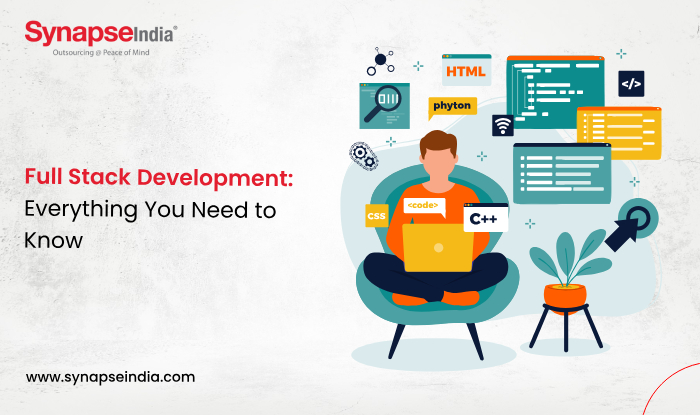 05 Oct 2024
05 Oct 2024
Full stack development is an intriguing choice for businesses looking to develop dynamic web applications. Not only this, but full stack development is also gaining popularity among developers, offering them a range of career opportunities. This comprehensive guide encompasses everything you need to know about full stack development ranging from the complete development stages to the tools and technologies involved and much more.

Full stack development refers to the comprehensive approach to creating web applications. In full stack development, both the client side (front end) and the server side (back end) of web applications are developed by skilled full stack developers who hold proficiency in creating complete web applications from scratch.
The front end of an application is the part that users interact with directly. It encompasses everything from the layout and design to the functionality of the user interface. Technologies like HTML, CSS, and JavaScript and frameworks like React, Angular, and Vue.js are commonly used for front-end development.
The back end, on the other hand, is responsible for server-side logic, database interactions, and application performance and manages data processing, authentication, and server configuration. Languages such as Node.js, Python, Ruby, or PHP, and databases like MySQL, PostgreSQL, or MongoDB are required to develop the back end of any application.
Several key components come together to create a cohesive, functional, and dynamic web application. These components are broadly categorized into front end, back end, version control systems, and APIs.
As already discussed, the front end of any application is the part that handles user interaction. The primary technologies used for full stack front-end development are:
The back end is the server side of the application, where business logic, database interactions, and server configuration occur. Its key elements include:
To seamlessly manage the changes made to the codebase and enhance collaboration among developers, version control systems are required.
Lastly, to facilitate communication between the front end and back end, APIs are required.
Now that we have learned a little about the major components of full stack development, let us dive deeper into the important tools and technologies used for full stack development.
Code editors
Code editors like Visual Studio Code, Sublime Text, and Atom provide features such as syntax highlighting, code completion, and version control integration, enhancing the coding experience.
Browser developer tools
Browser developer tools are essential for debugging and optimizing web applications. They allow developers to inspect HTML/CSS, monitor network requests, and analyze performance.
React.js
React.js is another popular framework for front-end development that enables the creation of large web applications that can change data, without reloading the page. It utilizes a component-based architecture, enabling efficient UI updates through a virtual DOM.
Vue JS
Vue JS is a popular open-source framework for developing single-page web applications. It simplifies the development of dynamic, scalable applications using a reactive data binding system and a component-based structure.
Bootstrap
The Bootstrap framework can be used to create fully responsive mobile-first websites. It provides a collection of pre-designed components, such as grids, buttons, and navigation bars, along with CSS and JavaScript utilities.
SASS
Syntactically awesome stylesheet, popularly abbreviated as SASS, is a CSS pre-processor that comes with useful features like variables, nested rules, built-in functions, etc. that are missing from CSS.
Tailwind CSS
Tailwind CSS is a utility-first CSS framework that allows developers to design custom user interfaces. Instead of predefined components, it provides low-level utility classes for styling elements directly in the markup, promoting flexibility, maintainability, and rapid prototyping.
Express.js
Express.js is used for efficient and scalable server-side development and that too very quickly and easily. With a set of features, including routing, middleware, and template engines, Express.js can build robust APIs and web applications.
Node.js
Node.js is a powerful JavaScript runtime that allows developers to use JavaScript for both front-end and back-end development. Known for its non-blocking, event-driven architecture, it is ideal for building scalable and high-performance network applications.
Django
Django is a high-level framework used for developing large-scale, database-driven, interactive web applications. It offers built-in features like an ORM, authentication, and an admin panel, streamlining the development process.
Ruby on Rails
Ruby on Rails is an ideal backend framework for the rapid development of prototypes and minimum viable products (MVPs). It follows the convention over configuration principle, enabling developers to create applications quickly with less code.
Laravel
Laravel is a popular PHP framework known for its elegant syntax that allows the creation of innovative web application development. With built-in tools like Eloquent ORM and Blade templating, Laravel promotes clean, maintainable code and rapid application development.
SQL Databases
Relational databases like MySQL, PostgreSQL, and SQLite use structured query language (SQL) for data manipulation. They ensure data integrity through relationships and constraints.
NoSQL Databases
Non-relational databases such as MongoDB, Cassandra, and Firebase offer flexibility for handling unstructured or semi-structured data. They are designed for scalability and performance, making them suitable for modern applications.
Git
Git enables developers to track code modifications, create branches for features, and merge changes seamlessly. It also promotes better communication, increases productivity, and allows for efficient project management throughout the development lifecycle.
GitHub/ GitLab/ Bitbucket
Platforms like GitHub, GitLab, and Bitbucket enhance collaboration by providing repositories for hosting code, issue tracking, and pull requests for code reviews. These tools allow teams to work concurrently, ensuring code integrity and reducing conflicts.
Heroku
Heroku is a cloud platform used for deploying web applications easily. It offers a Platform-as-a-Service (PaaS) environment, enabling effortless deployment of web apps with built-in scaling and monitoring features.
AWS (Amazon Web Services)
AWS is a popular deployment platform that provides a comprehensive suite of services, including Elastic Beanstalk for app deployment and S3 for storage. Developed and maintained by Amazon, AWS is suitable for large-scale applications.
Docker
Docker is a deployment tool ideal for facilitating deployment across various environments. It simplifies deployment through containerization, ensuring applications run consistently across different environments.
Netlify
Netlify focuses on front-end deployments, offering continuous deployment from Git repositories. With features like serverless functions and form handling, Netlify enhances productivity for developers.
To become a competent full stack developer, one should acquire a diverse set of skills. From technical to soft skills, here’s a complete list of expertise required for proficient full stack development.
The complete full stack development cycle comprises phases like planning and analysis, front-end and back-end development, testing and deployment and finally maintenance and support. Let us go through the different stages of the full stack development process one by one in brief.
The full stack development begins with an understanding of the project requirements. It is crucial to determine the application’s purpose, target audience, and necessary features before going deeper into the development process. Based on the data gathered, create wireframes and prototypes to visualize the design of your proposed full stack project.
The next step will be the development of the user interface based on the prototypes. Using languages such as HTML, CSS, and JavaScript, full stack developers will build responsive layouts and interactive elements. Furthermore, using frameworks like React or Vue.js can enhance user experience and streamline development.
Back-end development in full stack applications involves creating server-side logic, managing databases, and handling API interactions. Set up the server and database and create RESTful APIs to facilitate communication between the front end and back end. Also, implement business logic and handle data storage and retrieval.
After both the front-end and back-end of your web application are developed, perform rigorous testing to find and fix any issues. Make sure to perform JavaScript testing, API testing, and end-to-end testing using the appropriate tools.
Once testing is complete, deploy the application using a platform of your choice and set up a CI/CD pipeline to automate the deployment process.
After deployment, continuously monitor the application for bugs and performance issues. Gathering user feedback and making iterative improvements is important for the continuous performance of your web application.
Along with ongoing maintenance, strong support for your full stack development project is the key to maintaining the lifelong functionality of your web application.
Full stack development has gained immense popularity as it enables the creation of high-quality dynamic web applications. By allowing developers to manage both front-end and back-end tasks, it streamlines communication and reduces project timelines. Hiring expert full stack development services offers numerous advantages for businesses aiming to build robust web applications.

The growing demand for dynamic web applications has enhanced the appeal of full stack development. This has further increased the demand for experienced full stack developers who create comprehensive web applications and contribute significantly to projects. With a professional full stack development company, you get this expertise that can set your business on the path to success in this ever-evolving digital landscape.

 01 Jun 2024
01 Jun 2024
